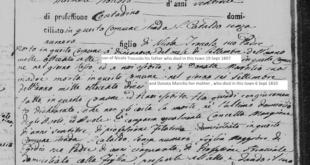Italian Possessive Adjectives for Things
Possessive adjectives allow one to describe ownership. Did you know that to describe possession in English, we simply put a possessive adjective (my, your, his/hers, etc.) before a noun under discussion? The word placement is the same in Italian. But there are otherwise many differences in the English and Italian approach to describing our relationship to the things we own.
In English, the possessive adjectives refer to the person who is the “owner” of the thing being talked about. However, the Italian use of possessive adjectives requires a different way of thinking, since Italians match the gender and number of the possessive adjective to the object or person referred to!
Where does this Italian possessive adjective/noun agreement come from? As we have already learned in our last blog, Adding Color with Adjectives, Italian adjectives must change their endings to match the gender and number of the noun they modify. Although an Italian possessive adjective describes the owner, the ending of the possessive adjective is linked to the object possessed — its masculine or feminine ending and how many of each are referred to.
In effect, we can have a masculine owner of a feminine object and the possessive adjective used will have a feminine ending, or vice versa. We must really think in Italian when we use Italian possessive adjectives!
Italian possessive adjectives are placed before the person, place, or thing they modify, just like in English, as already noted in the introduction. The Italian definite article, which is required before an Italian noun, is often included as part of the Italian possessive adjective. In this case, all three — definite article, possessive adjective, and noun — will agree in gender and number.
The table below lists the singular and plural possessive adjectives. Of course, there are four possessive adjectives to cover all situations that might occur in gender or number for any given noun. Notice from the table below that the masculine possessive adjectives end in -o/-i and the feminine possessive adjectives end in –a/-e, except for the third person plural form, loro, which is invariable. Since loro is invariable, it cannot be used without its definite article.
| Italian Singular Possessive Adjectives |
Italian Plural Possessive Adjectives |
|
| mio / mia | my | miei / mie |
| tuo / tua | your (familiar) singular | tuoi / tue |
| suo* / sua* | your (polite)* singular
his, her, its |
suoi* / sue*
|
| nostro / nostra | our | nostri / nostre |
| vostro / vostra | your (familiar) plural | vostri / vostre |
| loro | their | loro |
*To differentiate “polite your” from “his” or “hers” when writing, one can capitalize, as in, “il Suo amico” or “la Sua amica.”
Although the grammar for Italian possessive adjectives appears complicated at first, the matching endings flow easily when spoken and give Italian its beautiful musical cadence. In fact, in our last blog about Italian adjectives, several examples used possessive adjectives with their correct endings because they fit so easily into the sentences we were creating. Let’s take a look:
Anna è una ragazza europea; viene dalla Francia. Abita in compagna e d’estate dalla sua casa può vedere i fiori gialli, viola, e lilla.
Ann is a European girl; she is from France. She lives in the country, and during the summer from her house she can see yellow, violet, and light purple flowers.
Mio nonno Carmelo è un uomo italiano ma gli piace molto la sua casa in America. Lui ha dipinto la sua casa blu, come il mare italiano.
My grandfather Carl is an Italian man but he really likes his house in America. He painted his house blue, like the sea around Italy.
In both examples above, the Italian word casa was modified by “la sua” — to signify “hers” in the first case and “his” in the second case. Even though the two subjects’ gender is different the examples, the possessive adjective remains the same, since the ending is linked to the noun that follows. At this point, we won’t discuss combining “da” with “la,” as in the first example, since that is the topic for another blog!
Below are some simple sentences with examples of matching possessive adjectives and nouns. Remember that nouns that end in -e are designated as either masculine or feminine in Italian. If one is not sure, just check the definite article, which will be true to the gender of the noun! Notice again that the word order for nouns and adjectives in the English translation may differ from the Italian sentence.
Mi piace la mia macchina rossa.
I like my red car.
Questo è il tuo libro.
This is your book.
I nostri lavoratori sono bravi artigani.
Our workers are talented artisans.
Il loro cibo italiano è il migliore!
Their Italian food is the best!
It should be noted that the Italian definite article can be omitted if the speaker wants to emphasize ownership of a particular thing when using the verb essere. For instance, if the speaker in our first example wanted to stress his ownership of a car, he would simply say, “È mia,” for, “(It) is mine,” and omit the definite article la and the word macchina. In English, we use mine instead of my, ours instead of our and yours instead of your after the verb “to be” in a similar way. This is called the stressed form of the possessive adjective.
Finally, the expression “a casa mia,” with the possessive adjective placed alone, after the noun, is common and means “at/to my house.” The other possessive forms can be used as well with this phrase, as in “a casa tua” (at your house) or “a casa sua” (at his/her house). And, it can always be, “colpa mia” for “my fault.”
Italian Possessive Adjectives
for Family Members – Singular
Possessive adjectives are also used to talk about relationships between family members and friends in every language. In fact, the Italian use of the definite article to form the possessive adjective can yield clues to an individual’s interpersonal relationships.
For instance, when referring to a family member in the singular, the Italian possessive adjective is used alone, without it’s definite article. Of course husband, wife, mother, father, sister and brother do not need a definite article when you mention them in conversation or in writing. This holds true for the extended family as well.
Two examples from our last blog, which refer to the speaker’s cousin and grandfather:
Ti presento Caterina, mia cugina americana.
Let me introduce you to Kathryn, my American cousin.
Mio nonno Carmelo è un uomo italiano ma gli piace molto la sua casa in America.
My grandfather Carl is an Italian man but he really likes his house in America.
Following this line of thinking, when speaking of anyone “outside” the family, from a close friend to an acquaintance one barely knows, the Italian definite article is included with the Italian possessive adjective!
Oggi ho comprato un regalo per Francesca, la mia amica del cuore.
Today I bought a present for my dear friend Frances.
La mia conoscente Anna sarà alla festa stasera.
My acquaintance Ann will be at the party tonight.
How about that boyfriend or girlfriend? Or someone who is even closer to you — your fiancé or fiancée? Always use il mio fidanzato or la mia fidanzata for a boyfriend/fiancé or girlfriend/fiancée. Italian dictates that you must use the definite article, since these individuals are not yet officially a part of the family! Of course, your ex-husband or ex-wife is demoted to definite article use as well, as they have left the confines of the family; la mia ex moglie and il mio ex marito is Italian for my ex-wife and my ex-husband.
There are some exceptions to the “in or out” of the family as designated by the “Italian definite article rule.”
- When one uses the Italian words bambino/bimbo or bambina/bimba to speak about their baby, the Italian definite article is required by convention.
Il mio bambino/La mia bambina ha sei mesi.
My baby (boy or girl) is six months old.
- When using the Italian word famiglia to speak about “my family,” the definite article is also required by convention. Notice also that the noun family is used in the singular, although by definition it refers to a group of people (otherwise known as a “collective noun”). The Italian verb used with the subject “family” will be in the third person singular as a result.
La mia famiglia viene dall’Italia.
My family comes from/ is from Rome.
Finally, a word about those common, well-loved, furry American family members — dogs and cats. In America, many people are as close to their pets as they are to their other family members. Although Italians may be as attached to their pets as Americans, if a cat or a dog is a part of the family, Italians use the definite article when speaking about them, as in il mio gato or il mio cane. The endings of the nouns that refer to animals are not usually changed to match their gender. But, if it is important to emphasize that a pet is female, you can say, “la mia gata” (female cat) or “la mia cagnolina” (female dog). (For a female dog, one cannot simply add the letter a to the end of cagno to create the female counterpart of this noun; a simple a ending would create a word that today is used to refer to a woman in a vulgar way. The “lina” ending is added instead.)
Italian Possessive Adjectives
for Family Members – Plural
Although the Italian definite article takes on a particular importance in denoting family relationships in the singular, this is not the case in the plural. Instead, when speaking of more than one family member, the definite article must be always be used, just as with a friend or acquaintance.
For instance:
I nostri amici sono arrivati.
Our friends (They) have arrived.
I nostri cugini sono arrivati.
Our cousins (They) have arrived.
In the above cases, notice that the past participle arrivati also has an i ending. If you need a refresher on how to create the passato prossimo in Italian, please refer to our blog Italian Past: Avere vs. Essere.
Below are two summary tables for the possessive adjectives used to refer to close members of the family, one for the female members and one for the male members. Both singular and plural possessive adjectives have been included to emphasize use of the definite article in the plural.
La mia Famiglia Femminile – Female Members of My Family
| Italian Singular | Italian Plural | |
| Possessive Adjectives | Possessive Adjectives | |
| mia madre | my mother | |
| mia mamma | my mom | |
| mia sorella | my sister(s) | le mie sorelle |
| mia nonna | my grandmother(s) | le mie nonne |
| mia zia | my aunt(s) | le mie zie |
| mia figlia | my daughter(s) | le mie figlie |
| mia cugina | my female cousin(s) | le mie cugine |
La mia famiglia Maschile – Male Members of My Family
| Italian Singular | Italian Plural | |
| Possessive Adjectives | Possessive Adjectives | |
| mio padre | my father | |
| mio papà* | my dad | |
| mio fratello | my brother(s) | i miei fratelli |
| mio nonno | my grandfather(s) | i miei nonni |
| mio zio | my uncle(s) | i miei zii |
| mio figlio | my son(s) | i miei figli |
| mio cugino | my cousin(s) | i miei cugini |
* Papà, with the accent over the final a, means dad and is pronounced differently from papa, without the accent, which means the pope of the Catholic church.
Practice using Italian possessive adjectives when talking about
family and friends
and I guarantee you will use them every day!
For “All the Italian you need to enjoy your trip to Italy” click on the links for my Conversational Italian for Travelers books -Kathryn Occhipinti


 Fra Noi Embrace Your Inner Italian
Fra Noi Embrace Your Inner Italian






